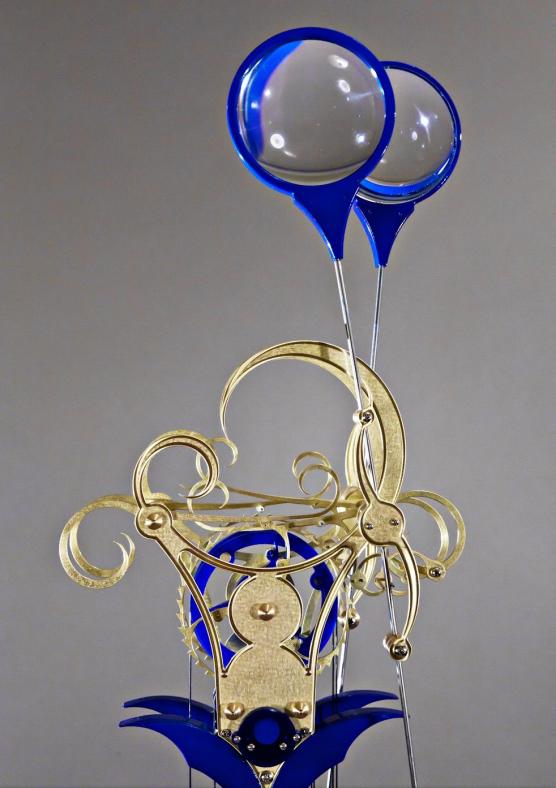Phil Abernethy - Galileo
- Galileo
- Copper and Aluminum
- 75 x 12 x 12 in
- 2014
- Price available on request
- Offsite
Not a clock as such, though it could easily be turned into a hybrid. This work is a play of double independant pendulums of differing lengths impulsed by independent escapements. Having independent escapements and pendulums means that it will have the orchestral effect of the escapements, with thier audible ticking, coupled with the curious visual effect of both the escapements and pendulums going in and out of phase. The lenses used are a reference to Galileo's contributions to astronomy and the composition is inspired by Gothic fashion of his time. The work is automatically wound and uses the Galileos escapement, which he invented circa 1637.
Technical Details: Galileo's escapement, Automatic winding. Brass and aluminum.
Galileo
I made this piece specifically for the 2015 Toronto International Art Show in recognition of Galileo’s 450th birthday.
The work is a play of double independent pendulums of differing lengths impulsed by independent escapements. This creates an orchestral effect of the escapements, with their audible ticking, coupled with the curious visual effect of both the escapements and pendulums going in and out of phase.
The lenses are a reference to Galileo's contributions to astronomy and the composition is inspired by Gothic fashion of his time. The work is automatically wound and uses Galileo’s escapement, which he invented circa 1637
Technical Details: Galileo's escapement, Automatic winding. Brass and aluminum.
Overall Dimensions: IN: 12W 12D 75H CM: 30W 30D 190H
Phil Abernethy was born in England to a family of clockmakers. After emigrating to Canada in 1976, he apprenticed to his father and became a journeyman clockmaker in 1988. After decades in the domestic and public clock field, their company, Abernethy & Son, has become widely regarded as masters of their craft in Canada and abroad. Drawing on his broad experience, Phil has pursued sculptural clockmaking, creating machines based on historic and obscure devices spread over the history of the craft. Phil works from his studio in Victoria, British Columbia, Canada.
“Being exposed to countless historic devices and systems in my work as a clock restorer over several decades, combined with a lifelong interest in art, it seems natural to explore the potential of clockwork as Art.
Through my experience as a restorer, and after much experimentation, I’ve developed systems that have allowed a sculptural approach to my craft, whilst illustrating its vast history. The reinterpretation of their mechanics, and format, exposes what has traditionally been hidden behind the work of other crafts.
Key to this exploration has been the development of contemporary reflections on traditional mechanics that are both functional in the long term and require little in the way of maintenance and adjustment. This is achieved through the use of sound design, significant prototyping, contemporary materials and components, and by drawing extensively on my field experience.
Visually in my own work I combine natural lines and organic forms with the easy cadence of slow beating pendulums that reflect a natural and more reflective experience of time.”
More Artwork from this Artist
The Dual Grasshopper
- Copper and Aluminum
- 87.5 x 13 x 8.5 in
- Price available on request
Galileo
- Copper and Aluminum
- 75 x 12 x 12 in
- 2014
- Price available on request
Insionn
- Copper and Aluminum
- 80 x 32 x 11 in
- 2014
- Price available on request
Figheadair
- Copper and Aluminum
- 26 x 12 x 5.5 in
- 2014
- Price available on request
Isochronal Awakening
- Copper and Aluminum
- 69 x 21.5 x 11 in
- 2014
- Price available on request







